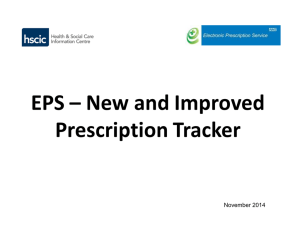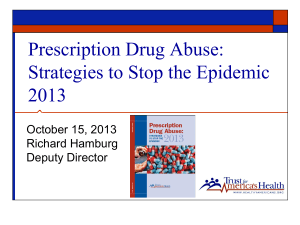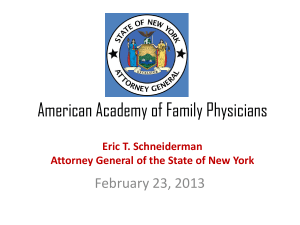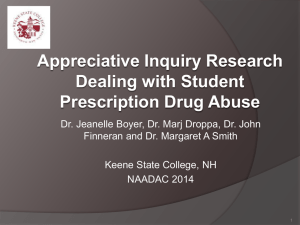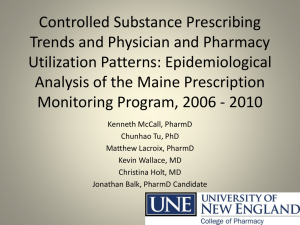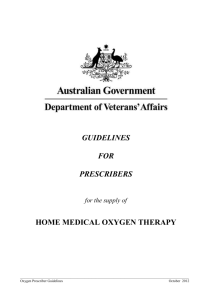Slides - Washington State Hospital Association
advertisement
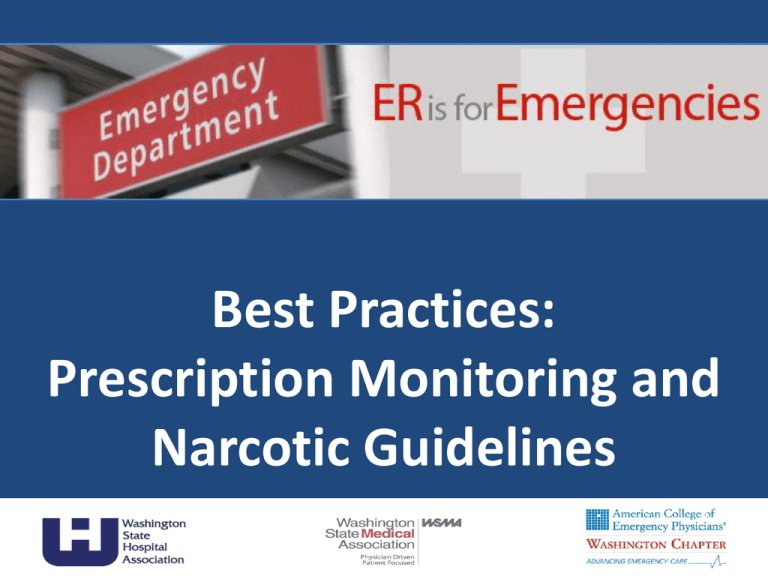
Best Practices: Prescription Monitoring and Narcotic Guidelines 1 WSHA Presenters Carol Wagner Amber Theel Senior VP, Patient Safety Director, Patient Safety 2 Additional Presenters Washington State Washington State Medical Department of Health Association Sacred Heart Medical Center Susan Peterson Associate Director, Legislative, Regulatory and Legal Affairs Dr. Darin Neven, ED Physician Chris Baumgartner, Director Prescription Monitoring Program 3 Web Conference Objectives • Background on ER is for Emergencies • Best Practice: Prescription Monitoring Program and Narcotic Guidelines • What is PMP? • How does it work? • How can we help? • Questions and comments 4 An Opportunity Redirecting Care to the Most Appropriate Setting 5 Partnering for Change • Washington State Hospital Association • Washington State Medical Association • Washington Chapter of the American College of Emergency Physicians 6 State Approaches to Curbing ER Use When Original proposal What Impact 3-visit limit on Cuts payments to unnecessary use providers Status Won lawsuit; policy abandoned Revised proposal No-payment for Cuts payment to unnecessary providers visits Current policy Adoption of best Improves care practices delivery and reliance on ER as source of care Delayed by the Governor just prior to implementation Passed in latest state budget 7 If Unsuccessful Revert to the no-payment policy. $38 million in annual cuts! 8 Seven Best Practices 9 The Seven Best Practices • • • • • • • Electronic health information Patient education PRC client information/identification PRC client care plans Narcotics guidelines Prescription monitoring Use of feedback information 10 E) Narcotic Guidelines Goal: Reduce drug-seeking and drug-dispensing to frequent ER users • Implement ACEP guidelines for prescribing and monitoring of narcotics • Direct patients to better resources • Track data and follow-up with providers who excessively prescribe 11 How to Accomplish • Change hospital policy to conform with ACEP guidelines: – – – – Prohibit long-acting opioids and discourage injections Screen patients for substance abuse Refer patients suspected of Rx abuse to treatment Other • Train ER prescribers in narcotic guidelines 12 How to Accomplish, continued • Consider joining this “oxy-free” movement • When guidelines have been implemented, hospitals have seen significant drop in visits 13 F) Prescription Monitoring Goal: Ensure coordination of prescription drug prescribing practices • Enroll providers in Prescription Monitoring Program: electronic online database with data on patients prescribed controlled substances • Target enrollment for ER providers : – 75% by June 15, 2012 – 90% by December 31, 2012 14 How to Accomplish • WSMA and WA/ACEP encourage members to sign up • Educate and encourage medical staff to enroll • Hospitals track enrollment of ER prescribers to report to HCA by June 15 and December 31, 2012 15 Washington State Prescription Monitoring Program: Background and History Carl Nelson, Director of Political Affairs Washington State Medical Association PMP Legislative History • HB 3320 by Rep. Hinkle in 2006. • HB 1553 by Rep. Hinkle, Rep. Morrell and others in 2007. • SB 5930 The Blue Ribbon Commission. • 2007 Session Laws, Chapter 259, section 42 through 45. • Providers oppose licensure tax. • Funding source remains issue. Washington State Hospital Association WA Prescription Monitoring Program Chris Baumgartner, Director Overview - 2012 Unintentional and Undetermined Intent Drug Overdose Death Rates by State, 2007 12.3 9.7 10.5 3.7 5.3 11.1 7.1 9.2 3.1 9.8 10.5 4.8 4.1 16.0 12.7 8.2 10.8 18.4 8.7 12.5 21.1 11.7 12.5 7.4 7.6 16.8 20.4 10.4 15.1 7.1 10.0 14.2 10.5 9.4 10.0 10.2 8.6 NH VT MA RI CT NJ DE MD DC 11.7 7.9 12.5 11.1 11.1 7.5 9.8 12.5 8.8 8.2 17.9 13.6 9.0 9.9 Age-adjusted rate per 100,000 population 3.1-9.0 9.1-11.4 11.5-21.1 Non-medical Use of Pain Relievers 12 or Older, 2007 & 2008 Source: National Survey on Drug Use & Health, SAMSHA The PMP Solution: An Overview • Designed to improve patient safety and prevent prescription drug abuse by keeping records of all dispenser transactions • Store and evaluate records for illicit use of prescription drugs • Generate reports to aide prescribers, dispensers, law enforcement, and licensing entities in stopping illicit use Status of Prescription Drug Monitoring Programs (PDMPs) VT ME WA MT ND OR MN SD ID MI WY NE NV UT CO CA AZ KS OK NM NY WI IA IL OH IN WV VA NC TN AK G U GA Operational PDMPs FL Enacted PDMP legislation, but program not yet operational Legislation pending HI Research is current as of April 26, 2012 SC AR LA DC KY MO MS AL TX PA NH MA RI CT NJ DE MD Implementation Update 2011 • Begin Data Collection – October 1 • Begin Mandatory Reporting – October 7 • Begin DOH/PMP Staff/Licensing Board Access – October 26 • Begin Oversight Agencies Access – November 15 • Begin Pilot Data Requestor Access – December 1 2012 • Begin Data Requestor Access – January 4 • Begin Law Enforcement/Prosecutorial Agencies Access – January 4 • Begin Medical Examiners/Coroners Access – February 1 • Operations, Maintenance, Enhancements – ongoing DOH’s Goals for Washington’s PMP • To give practitioners an added tool in patient care • To allow prescribers and dispensers to have more information at their disposal for making decisions • To get those who are addicted into proper treatment • To help stop prescription overdoses • To educate the population on the dangers of misusing prescription drugs • To make sure that those who do need scheduled prescription drugs receive them • To curb the illicit use of prescription drugs System Overview Dispensers -Weekly Submission - Schedules II-V Data Submitted - ASAP 4.1 Reports Sent Pharmacists State PMP Prescribers Reports Sent Reports Sent Law Enforcement & Licensing *Other groups may also receive reports other than those listed Who Isn’t Required to Submit Data • Prescriptions provided to patients receiving inpatient care at hospitals • Practitioners who directly administer a drug • A licensed wholesale distributor or manufacturer • Pharmacies operated by the Department of Corrections • VA or other federally operated pharmacies • Canadian pharmacies that are not licensed to dispense in Washington Who Has Access • Prescribers & dispensers - in regards to their patients • Licensing boards – in regards to investigations • Individuals – in regards to any prescription dispensed to them • DOH/Vendor – in regards to program operation • Law Enforcement/Prosecutor – for bona fide specific investigations • Medical Examiner/Coroner – cause of death determination • HCA (Medicaid), L&I (Worker’s Comp), DOC (Offenders) • De-identified information may be provided for research and education Highest Number of Scripts Per Person by County County Columbia Garfield Stevens Ferry Clallam Lincoln Benton Spokane Asotin Pend Oreille Scripts 10,810 2,810 44,544 7,858 72,285 9,967 162,763 452,149 20,240 12,177 Population 4,040 2,101 42,334 7,520 71,413 10,248 168,294 468,684 21,432 12,946 •Data pulled 03/30/12, Jan2011-Feb2012, US 2009 Census Estimates Scripts Per Person 2.68 1.34 1.05 1.04 1.01 0.97 0.97 0.96 0.94 0.94 Top 10 Drugs by Rx Count * Data pulled 03/30/12 covers CY 2011 Rank Generic Name Number of RX Total QTY Total Days Supply 1 HYDROCODONE /ACETAMINOPHEN 944,575 49,889,601 11,135,234 2 OXYCODONE /ACETAMINOPHEN 302,243 16,867,961 3,428,399 3 ZOLPIDEM 285,167 8,845,839 8,455,383 4 OXYCODONE 270,425 25,736,912 4,722,338 5 ALPRAZOLAM 200,471 10,524,485 4,601,852 6 LORAZEPAM 189,683 8,650,802 3,880,719 7 CLONAZEPAM 155,956 9,284,932 4,501,441 8 AMPHETAMINE 135,177 7,273,681 4,012,796 9 METHYLPHENIDATE HCL 119,464 6,322,550 3,650,637 10 MORPHINE SULFATE 97,552 7,337,202 2,272,666 Just Two Months of Prescriptions! * Data pulled 3/30/12 (January – February 2012) # of # of # of # of individuals # of # of individuals # of individuals individuals with State individuals individuals with CIV individuals with CII and with CII, Controlled with CII Rxs with CIII RxsRxs with CV Rxs CIII Rxs CIII, CIV Rxs Rxs 296,718 383,557 336,677 63,381 54,403 19,447 2,011 Generated Reports • A series of reports can be developed as data collection progresses. Reports include: ▫ Patient history reports ▫ Reports that show that patients have exceeded a threshold considered a safe level of dispensing ▫ Prescriber history reports ▫ De-identified reports for research/education ▫ Other reports can be generated for specialized interests and needs Sub-accounts for Prescribers • The rule allows for “licensed health care practitioner authorized by a prescriber” to access information as a delegate • Any health professional licensed by the department can have a sub-account • Prescribers will be able to link subaccounts to their main account to make requests on their behalf Two Factor Authentication • Virtual tokens authenticate a user’s device (process is similar to online banking) • The device can be a desktop, laptop, tablet, or smart phone • Once a device is enrolled the user can simply login with their username and password • Additional computers can be enrolled PMP Registration: 5,204 Total Prescribers Pharmacists – 1,681 Medical Doctor – 2,706 Medical Limited – 71 Physician Fellowship – 0 Teaching/Research – 2 Osteopathic Physician – 239 • Osteopathic Limited – 6 • Physician Assistant – 519 • Osteopathic PA – 13 • • • • • • • Nurse Practitioner – 753 • Dentist – 770 • Dental Com. Resident – 0 • Dental UW Resident – 1 • Dental Faculty – 0 • Podiatric Phys. – 37 • Naturopaths – 34 • Optometrist – 40 • Veterinarian - 13 Provider Requests (as of 4/12/2012) • 95,794 patient history requests have been made • 2,043 prescriber history requests have been made Provider Quote "Now that I've started using this system, it's almost hard for me to imagine how I was practicing medicine without it. Whenever I prescribe scheduled meds now, I routinely search the Prescription Monitoring Program database, to ensure that the patient isn't getting similar meds from another provider. It is amazing to me how often this search reveals that the patient actually was getting such meds somewhere else, and just not providing this information. Finding this out helps prevent abuse of the system and thus keep costs down for everyone. Most importantly, it helps to keep patients safe and allows us to get them the help that they truly need." www.wapmp.org Uses for Prescribers/Pharmacists • Prescription history of a current or a new patient • Check for addiction or undertreated pain • Check for misuse, multiple prescribers • Check for drug interactions or other harm • Use reports for compliance with pain contracts • Prescription history of transactions linked to a DEA number • Check for fraudulent scripts • Regular monthly reporting PMP Education Materials Timeline Brand design - DONE Dispenser Requirement Factsheet DONE Public factsheet - DONE Provider factsheet – DONE FAQs – DONE Quick Tips - DONE Future Enhancements • Share data with other State PMPs • Interface with the Emergency Department Information Exchange • Education programs • Health information exchange • Outcome evaluation Program Contact • Chris Baumgartner, Program Director • Phone: 360.236.4806 • Email: prescriptionmonitoring@doh.wa.gov • Website: http://www.doh.wa.gov/hsqa/PMP/default.htm Experience in the Hospital 42 Sacred Heart Medical Center • How are the ER providers incorporating the narcotic guidelines into their practice at Sacred Heart? • How does the prescription monitoring program assist them in their efforts? • What are the challenges? 43 Next Steps How We Will Help 44 Review: What Do You Need to Do? Reduce drug-seeking and drug-dispensing to frequent ER users and coordinate prescription drug prescribing practices •Implement ACEP guidelines for prescribing and monitoring of narcotics •Direct patients to better resources •Track data and follow-up with providers who are outliers • Enroll ER physicians in Prescription Monitoring Program – 75% by June 15, 2012 – 90% by December 31, 2012 45 Quick Action Needed! Hospitals must submit attestations and best practice checklists to HCA by June 15, 2012 46 For More Information Carol Wagner, Senior VP, Patient Safety (206) 577-1831, carolw@wsha.org Amber Theel, Director, Patient Safety Practices (206) 577-1820, ambert@wsha.org 47 Questions and Comments 48
